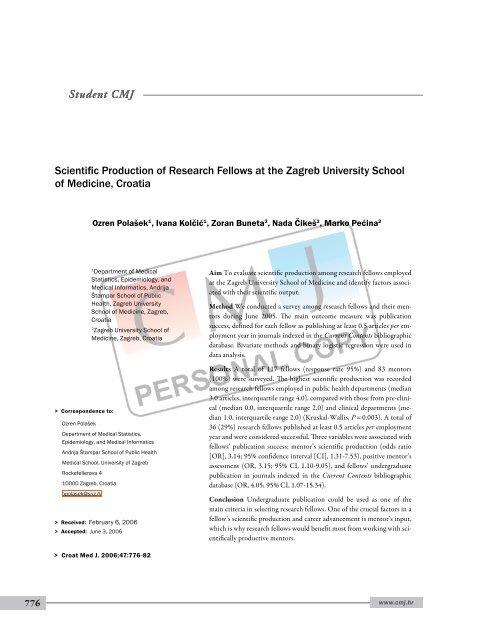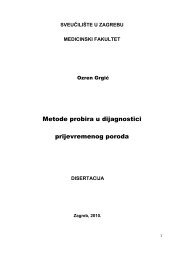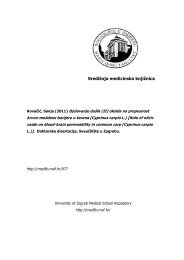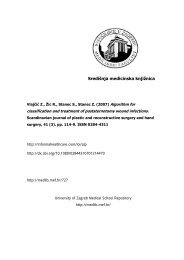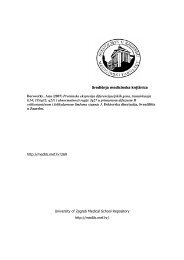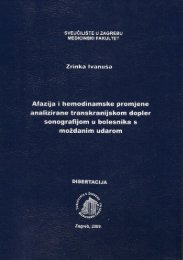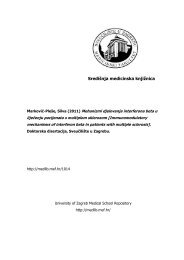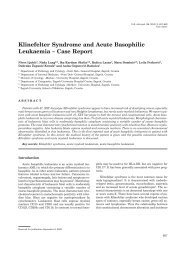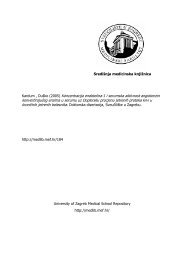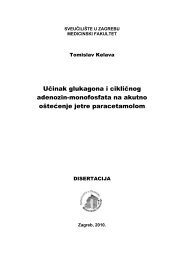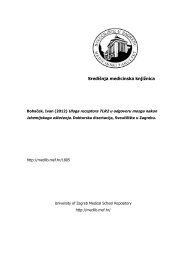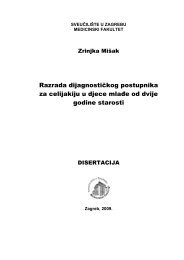pdf (519 KB), English, Pages 730
pdf (519 KB), English, Pages 730
pdf (519 KB), English, Pages 730
You also want an ePaper? Increase the reach of your titles
YUMPU automatically turns print PDFs into web optimized ePapers that Google loves.
776<br />
Student CMJ<br />
Scientific Production of Research Fellows at the Zagreb University School<br />
of Medicine, Croatia<br />
> Correspondence to:<br />
Ozren Polašek<br />
Ozren Polašek 1 , Ivana Kolčić 1 , Zoran Buneta 2 , Nada Čikeš 2 , Marko Pećina 2<br />
1 Department of Medical<br />
Statistics, Epidemiology, and<br />
Medical Informatics, Andrija<br />
Štampar School of Public<br />
Health, Zagreb University<br />
School of Medicine, Zagreb,<br />
Croatia<br />
2 Zagreb University School of<br />
Medicine, Zagreb, Croatia<br />
Department of Medical Statistics,<br />
Epidemiology, and Medical Informatics<br />
Andrija Štampar School of Public Health<br />
Medical School, University of Zagreb<br />
Rockefellerova 4<br />
10000 Zagreb, Croatia<br />
opolasek@snz.hr<br />
> Received: February 6, 2006<br />
> Accepted: June 3, 2006<br />
> Croat Med J. 2006;47:776-82<br />
Aim To evaluate scientific production among research fellows employed<br />
at the Zagreb University School of Medicine and identify factors associated<br />
with their scientific output.<br />
Method We conducted a survey among research fellows and their mentors<br />
during June 2005. The main outcome measure was publication<br />
success, defined for each fellow as publishing at least 0.5 articles per employment<br />
year in journals indexed in the Current Contents bibliographic<br />
database. Bivariate methods and binary logistic regression were used in<br />
data analysis.<br />
Results A total of 117 fellows (response rate 95%) and 83 mentors<br />
(100%) were surveyed. The highest scientific production was recorded<br />
among research fellows employed in public health departments (median<br />
3.0 articles, interquartile range 4.0), compared with those from pre-clinical<br />
(median 0.0, interquartile range 2.0) and clinical departments (median<br />
1.0, interquartile range 2.0) (Kruskal-Wallis, P = 0.003). A total of<br />
36 (29%) research fellows published at least 0.5 articles per employment<br />
year and were considered successful. Three variables were associated with<br />
fellows’ publication success: mentor’s scientific production (odds ratio<br />
[OR], 3.14; 95% confidence interval [CI], 1.31-7.53), positive mentor’s<br />
assessment (OR, 3.15; 95% CI, 1.10-9.05), and fellows’ undergraduate<br />
publication in journals indexed in the Current Contents bibliographic<br />
database (OR, 4.05; 95% CI, 1.07-15.34).<br />
Conclusion Undergraduate publication could be used as one of the<br />
main criteria in selecting research fellows. One of the crucial factors in a<br />
fellow’s scientific production and career advancement is mentor’s input,<br />
which is why research fellows would benefit most from working with scientifically<br />
productive mentors.<br />
www.cmj.hr
Decreasing interest in scientific involvement<br />
among young graduate physicians has been identified<br />
in a number of studies (1-6). Various solutions<br />
for reversing this trend have been proposed<br />
in an attempt to increase the interest in scientific<br />
research among physicians. What was most<br />
commonly reported as having a positive effect on<br />
physicians’ research interest was undergraduate<br />
involvement in scientific work and subsequent<br />
publication of a research article (7-9). Other<br />
studies demonstrated that program characteristics<br />
and faculty size had an effect on publication<br />
output (10,11). The role of a supportive mentor<br />
(10,12), or a Resident Research Director (13)<br />
were also positively associated with scientific production.<br />
An additional year devoted to clinical<br />
research among surgical residents increased their<br />
scientific output (14). However, a recent study<br />
failed to confirm undergraduate scientific involvement<br />
as the predictor of productive scientific<br />
career in radiology (15). Only critical attitude,<br />
independence, inventiveness, and curiosity were<br />
correlated with research activity (16). Other undergraduate<br />
indicators, including grade point average,<br />
did not contribute to increased scientific<br />
production later in career (16). The situation<br />
is becoming even more worrying knowing that<br />
high initial interest in scientific research among<br />
recently graduated physicians decreased as their<br />
residency progressed (17). The reasons for a decreased<br />
publication output might include a lack<br />
of time, low interest in research, and insufficient<br />
mentor support (18). Inadequate senior staff and<br />
statistical or secretarial support were identified as<br />
major barriers to research activity (19). The same<br />
study identified high demand for clinical productivity,<br />
lack of protected research time, and a lack<br />
of research funding as additional obstacles (19).<br />
In 1991, Ministry of Science, Education, and<br />
Sports of the Republic of Croatia established a<br />
program for research fellows, with an aim to attract<br />
the best graduate students to the positions<br />
at academic and research institutions. The number<br />
of research fellows gradually increased from<br />
Polašek et al: Scientific Production of Research Fellows<br />
995 in 1991 to 2510 at the end of 2005 (20). Career<br />
advancement criteria for research fellows are<br />
strict, and defined by the Law on Scientific Work<br />
and Higher Education (21). Research fellows<br />
employed by the Zagreb University School of<br />
Medicine represented a total of 5% of all research<br />
fellows in Croatia in 2004 and 26% of all fellows<br />
employed in the biomedical field (20). The aim<br />
of this study was to evaluate the scientific production<br />
among research fellows from Zagreb<br />
University School of Medicine. We also aimed<br />
to identify the factors associated with a successful<br />
scientific output, which is the main career advancement<br />
requirement for research fellows.<br />
Subjects and methods<br />
Setting<br />
Academic institutions in Croatia employ the best<br />
graduates as research fellows, with undergraduate<br />
grade point average as the main selection criterion.<br />
Fellows are employed on a six-year contract,<br />
and their salaries are provided by the Ministry of<br />
Science, Education, and Sports of the Republic<br />
of Croatia.<br />
Zagreb University School of Medicine most<br />
commonly employs graduate physicians (MDs)<br />
as research fellows. Fellows are attached to a research<br />
project funded by the Ministry of Science,<br />
Education, and Sports. The principal investigator<br />
of the project has a crucial role in the process<br />
of selecting the fellows and becomes the fellows’<br />
mentor.<br />
Fellows are required to take part in undergraduate<br />
and postgraduate teaching. Those employed<br />
in clinical and public health sciences can<br />
apply for residency training (specialization) in<br />
the field of medicine related to the research grant.<br />
Fellows employed at pre-clinical departments are<br />
also awarded a residency, when applicable.<br />
Fellows are also required to complete a threeyear<br />
postgraduate doctoral study program at<br />
Medical School. The main condition for the<br />
777
778<br />
Croat Med J 2006;47:776-782<br />
completion of a doctoral program and advancement<br />
to the PhD degree is scientific production.<br />
A fellow has to obtain a strictly defined score,<br />
based on the completion of postgraduate courses<br />
and publications in internationally visible<br />
journals. The journals are classified in two main<br />
groups: those indexed in Index Medicus bibliographic<br />
database and those indexed in the Current<br />
Contents bibliographic database. Journals<br />
indexed in the Current Contents database receive<br />
an impact factor of the Thompson Scientific,<br />
former Institute for Scientific Information, as<br />
a measure of the journal’s scientific impact (22).<br />
Articles in these journals are highly valued for academic<br />
and research advancement in Croatia. In<br />
addition, a fellow must be the first author of an<br />
article related to his or her PhD thesis, published<br />
in a journal indexed in the Current Contents database.<br />
Surveys<br />
This study was based on two separate questionnaires<br />
(web extra; available at http://www.cmj.<br />
hr). One was distributed to research fellows and<br />
the other to their mentors. Questionnaires were<br />
simultaneously distributed in June 2005.<br />
The fellows’ questionnaire consisted of 23<br />
questions, grouped in 8 sections: general data,<br />
employment details, research involvement,<br />
publication details, professional development,<br />
teaching obligations, clinical obligations, and<br />
other remarks. All data on fellows’ self-reported<br />
publications were checked against PubMed<br />
(http://www.pubmed.com), while the information<br />
on journal citation coverage was obtained<br />
from JAKE (http://jake.med.yale.edu/index.jsp).<br />
PubMed search was also performed for fellows<br />
who did not respond the survey, in order to obtain<br />
a full data set. Employment details for research<br />
fellows who did not respond were obtained<br />
from the Human Resources Department<br />
of the School.<br />
Questions with open-ended answers were<br />
independently coded and compared by two au-<br />
thors (OP and IK). Differences in the coding<br />
schemes were further evaluated and unified. Four<br />
answers were omitted from the study due to persistent<br />
discrepancies.<br />
The mentors’ questionnaires consisted of 9<br />
questions assessing the fellow’s postgraduate education,<br />
thesis preparation process, research involvement,<br />
teaching skills, and performance in<br />
the fellow’s professional commitments. Openended<br />
answers were processed in a similar way as<br />
those in the fellows’ surveys. Overall mentor’s assessment<br />
was coded as positive, neutral, or negative.<br />
An assessment was considered positive if the<br />
mentor indicated that the fellow had achieved<br />
progress in any area of the work. If the mentor<br />
simply listed the fellow’s activities without any<br />
evaluation, it was regarded as a neutral assessment.<br />
Mentor’s scientific output details were<br />
taken from the School’s database on employees’<br />
publication data (23).<br />
Statistical analysis<br />
Due to previously reported differences in scientific<br />
production among pre-clinical, clinical, and<br />
public health departments (24), these three department<br />
groups were analyzed separately. Research<br />
fellows employed at the Pathology Department<br />
were categorized as belonging to a<br />
pre-clinical department, as well as fellows working<br />
on a research grant related to the Croatian<br />
Medical Journal Editorial. Fellows employed at<br />
Andrija Štampar School of Public Health were<br />
considered to be employed in the public health<br />
departments.<br />
Non-normal distribution of data warranted<br />
the use of non-parametric statistical tests<br />
(Mann-Whitney and Kruskal-Wallis test). χ 2<br />
test was used to analyze categorical data. Fisher<br />
exact test was used if a contingency table contained<br />
less than 5 cases in a cell. Due to variable<br />
fellowship duration, annual scientific production<br />
was calculated as the number of published papers<br />
indexed in Current Contents bibliographic<br />
database divided by the number of employment
years. Multivariate analysis was performed with<br />
binary logistic regression. Criterion variable for<br />
logistic regression was publication success, defined<br />
as positive in fellows who authored or coauthored<br />
at least 0.5 articles per employment year<br />
in journals indexed in the Current Contents bibliographic<br />
database. Fellows who published less<br />
were considered unsuccessful.<br />
Mentors were ranked into three ordinal<br />
groups according to their scientific production in<br />
the last three years. Quartile values were calculated<br />
and the following three groups were formed:<br />
below average (1st quartile), average (2nd and<br />
3rd quartile), and above average (4th quartile).<br />
All analyses were performed using the Statistical<br />
Package for the Social Sciences, version 12.0.0<br />
(SPSS Inc., Chicago, IL, USA), with the significance<br />
level set at P
780<br />
Croat Med J 2006;47:776-782<br />
Table 2. Research fellow’s publication success and mentor’s scientific production group among the research fellows from the Medical<br />
School, University of Zagreb*<br />
No. of publications of fellows by mentor’s scientific production group<br />
No. of articles per employment year in journals<br />
indexed in the Current Contents database<br />
below average<br />
(1st quartile)<br />
A total of 36 (29%) fellows published at least<br />
0.5 articles in journals indexed in the Current<br />
Contents database per employment year, without<br />
differences among the 3 investigated department<br />
groups (χ 2 2 = 3.56, P = 0.169).<br />
We recorded significant differences in the<br />
number of fellows who published scientific articles<br />
as undergraduate students, with the highest<br />
number of fellows who published in public<br />
health departments (Fisher exact test P = 0.028).<br />
We detected a borderline insignificant difference<br />
among department groups in the number of fellows<br />
who were employed longer than three years<br />
without publishing a single article in journals indexed<br />
in the Current Contents database (Fisher<br />
exact test P = 0.052) (Table 1).<br />
During employment, research fellows attended<br />
a median of 3.0 international meetings (interquartile<br />
range 7.0), with no difference among<br />
the 3 department groups (Kruskal-Wallis test,<br />
P = 0.324). Significant differences were recorded<br />
in the average number of international training<br />
courses (Kruskal-Wallis test P = 0.003). Between-group<br />
comparison revealed that fellows in<br />
public health participated at more training courses<br />
than those in pre-clinical (Mann-Whitney test<br />
Z = -2.50, P = 0.013) or in clinical departments<br />
(Z = -3.33, P = 0.001), with no indication of differences<br />
between clinical and pre-clinical departments<br />
(Z = -1.32, P = 0.186).<br />
Fellows’ publication success was significantly<br />
associated with mentor’s scientific production<br />
group (Fisher exact test P = 0.001) (Table 2).<br />
Binary logistic regression model with fellow’s<br />
publication success as a criterion variable provided<br />
a good data fit (Hosmer-Lemeshow test,<br />
average<br />
(2nd and 3rd quartile)<br />
P = 0.442), with Nagelkerke R 2 = 0.22. Three<br />
variables were significantly associated with fellows’<br />
publication success: undergraduate publication<br />
of an article in journals indexed in the<br />
Current Contents database (OR, 4.05; 95%CI,<br />
1.07-15.34), positive mentor’s assessment (OR,<br />
3.15; 95%CI, 1.10-9.05), and mentor’s scientific<br />
production group (OR, 3.14; 95%CI, 1.31-7.53)<br />
(Table 3).<br />
Discussion<br />
above average<br />
(4th quartile) total<br />
Publication success (>0.5) No. (%) 2 (11) 19 (27) 15 (46) 36 (29)<br />
Unsuccessful fellows (
graduate publications and mentor’s supportive<br />
role are the main factors associated with a successful<br />
scientific output (7-10,12).<br />
Zagreb University School of Medicine management<br />
acknowledged several difficulties related<br />
to its scientific production: (i) problems related<br />
to structural organization of the School of<br />
Medicine (administratively and geographically<br />
isolated research units), (ii) high workload of researchers<br />
with teaching and routine professional<br />
obligations, (iii) insufficient and obsolete equipment,<br />
and finally (iv) insufficient funding (25).<br />
Lack of any scientific output during 1995-1999<br />
was recorded for 15% professors and 45% assistants<br />
from the School of Medicine (24).<br />
According to our study, research fellows in<br />
public health had the highest scientific production.<br />
Lower scientific output among fellows in<br />
clinical departments may be explained by their<br />
higher workload, while financial requirements<br />
and more complex research area might explain<br />
weak pre-clinical scientific production. In contrast,<br />
research fellows in public health and clinical<br />
sciences have a relatively easy access to large<br />
quantity of data routinely produced by the health<br />
care system. Less intensive workload and higher<br />
attendance at training courses could explain the<br />
highest scientific output by public health fellows.<br />
Participation in research projects among undergraduate<br />
students is common in Croatia (26-<br />
28) and is highly valued in career advancement.<br />
The results of this study confirm a previous report<br />
that an undergraduate publication of scientific<br />
article may serve as a significant success<br />
predictor (7). Although there is an association<br />
between the grade point average and undergraduate<br />
involvement in scientific research (26), we<br />
did not include grade point average in our model<br />
because it presented the primary selection criterion<br />
for research fellows.<br />
There are several limitations to this study.<br />
First, the study included a diverse group of research<br />
fellows that consisted of three subgroups<br />
(pre-clinical, clinical, and public health depart-<br />
Polašek et al: Scientific Production of Research Fellows<br />
ments). Each of these subgroups has specific publication-related<br />
problems and trajectories of the<br />
scientific production. Some specialties, like family<br />
medicine, are less likely to be involved in research<br />
activities (29). Additionally, substantially<br />
smaller scientific output than expected was recorded<br />
for some clinical areas in Croatia, eg, cardiology<br />
(30). Another potential bias might have<br />
occurred in mentor’s assessment, as mentor’s decision<br />
could have been affected by the research<br />
fellow’s scientific production. Finally, the main<br />
measure in this study was authorship or co-authorship<br />
of research fellows, which is the main<br />
element of the career advancement criteria. The<br />
consequence of this is that the number of authorships<br />
presented here overestimates the actual<br />
number of published articles, as two or more fellows<br />
could have co-authored a single paper.<br />
Evidence-based evaluation and careful planning<br />
are in essence of any functional human resources<br />
management system. This is even more<br />
pronounced in medical science, where an individual’s<br />
career takes a very long time to develop.<br />
Research fellows are valuable human resources<br />
for the development of the Medical School’s future<br />
staff. Results presented here suggest that undergraduate<br />
publication of an article in journals<br />
indexed in major international databases should<br />
be one of the main criteria when choosing research<br />
fellows. Mentor’s role in young researcher’s<br />
career advancement is crucial. Attachment<br />
to a mentor who has low scientific production is<br />
likely to result in an unsuccessful fellow’s scientific<br />
output and a delay in advancement to the PhD<br />
degree. Research fellows in biomedicine would<br />
benefit most from working with mentors who<br />
are more scientifically productive.<br />
References<br />
1 Rosenberg L. Physician-scientists – endangered and<br />
essential. Science. 1999;283:331-2. Medline:9925491<br />
2 Littlefield JW. The need to promote careers that combine<br />
research and clinical care. J Med Educ. 1986;61:785-9.<br />
Medline:3761339<br />
3 Brinkley WR. Disappearing physician-scientists. Science.<br />
1999;283:791. Medline:10049119<br />
781
782<br />
Croat Med J 2006;47:776-782<br />
4 Berkow R, Cohen J. The cri$i$ in academic medicine. Croat<br />
Med J. 2005;46:4-9. Medline:15726669<br />
5 Clark J, Smith R. BMJ Publishing Group to launch an<br />
international campaign to promote academic medicine.<br />
BMJ. 2003;327:1001-2. Medline:14593006<br />
6 Bosman FT. Academic medicine: dream or nightmare?<br />
Croat Med J. 2004;45:371-4. Medline:15311406<br />
7 Evered DC, Anderson J, Griggs P, Wakeford R. The<br />
correlates of research success. BMJ. 1987;295:241-6. Clin<br />
Res Ed. Medline:3115391<br />
8 Hillman BJ, Fajardo LL, Witzke DB, Cardenas D, Irion<br />
M, Fulginiti JV. Factors influencing radiologists to<br />
choose research careers. Invest Radiol. 1989;24:842-8.<br />
Medline:2807798<br />
9 Solomon SS, Tom SC, Pichert J, Wasserman D, Powers<br />
AC. Impact of medical student research in the development<br />
of physician-scientists. J Investig Med. 2003;51:149-56.<br />
Medline:12769197<br />
10 Mills OF, Zyzanski SJ, Flocke S. Factors associated with<br />
research productivity in family practice residencies. Fam<br />
Med. 1995;27:188-93. Medline:7774779<br />
11 Henderson SO, Brestky P. Predictors of academic<br />
productivity in emergency medicine. Acad Emerg Med.<br />
2003;10:1009-11. Medline:12957989<br />
12 Steiner JF, Lanphear BP, Curtis P, Vu KO. Indicators of<br />
early research productivity among primary care fellows. J<br />
Gen Intern Med. 2002;17:845-51. Medline:12406356<br />
13 Durning SJ, Cation LJ, Ender PT, Gutierrez-Nunez<br />
JJ. A resident research director can improve internal<br />
medicine resident research productivity. Teach Learn Med.<br />
2004;16:279-83. Medline:15388386<br />
14 Thomas JB, Cofer JB, Lewis PL, Burns RP. Clinical research<br />
during surgery residency: the Chattanooga approach. Curr<br />
Surg. 2000;57:135-9. Medline:16093044<br />
15 Patterson SK, Fitzgerald JT, Boyse TD, Cohan RH. Is<br />
past academic productivity predictive of radiology resident<br />
academic productivity? Acad Radiol. 2002;9:211-6.<br />
Medline:11918376<br />
16 O’Brecht M, Friesen H. Predicting career success. Science.<br />
1996;273:1156-7. Medline:8787117<br />
17 Neacy K, Stern SA, Kim HM, Dronen SC. Resident<br />
perception of academic skills training and impact on<br />
academic career choice. Acad Emerg Med. 2000;7:1408-15.<br />
Medline:11099432<br />
18 Ullrich N, Botelho CA, Hibberd P, Bernstein HH.<br />
Research during pediatric residency: predictors and<br />
resident-determined influences. Acad Med. 2003;78:1253-<br />
8. Medline:14660429<br />
19 Webster JB, Parker JC, Moore DP, Johnson JC. Research<br />
activities and perspectives of individuals completing a<br />
research enrichment program for physiatrists. Am J Phys<br />
Med Rehabil. 2003;82:403-9. Medline:12704282<br />
20 Research fellow project. Ministry of science, education, and<br />
sports, Republic of Croatia. [In Croatian] Available from:<br />
http://public.mzos.hr/Download/2006/01/16/prezentacija_<br />
novaka2.pps Accessed September 12, 2006.<br />
21 Law on scientific work and higher education [In Croatian].<br />
Narodne novine. 2003;(123):1742.<br />
22 Garfield E. Use of Journal Citation Reports and Journal<br />
Performance Indicators in measuring short and long<br />
term journal impact. Croat Med J. 2000;41:368-74.<br />
Medline:11063757<br />
23 Medical School employee’s publication data. Available from:<br />
http://smk.mef.hr/mef. Accessed: September 13, 2005;<br />
intranet password protected access.<br />
24 Petrak J, Bozikov J. Journal publications from Zagreb<br />
University Medical School in 1995-1999. Croat Med J.<br />
2003;44:681-9. Medline:14652879<br />
25 Scientific activities at the Medical School, University of<br />
Zagreb http://www.mef.hr/znanost/index.html. Accessed<br />
December 19, 2005.<br />
26 Kolcic I, Polasek O, Mihalj H, Gombac E, Kraljevic V,<br />
Kraljevic I, et al. Research involvement, specialty choice,<br />
and emigration preferences of final year medical students in<br />
Croatia. Croat Med J. 2005;46:88-95. Medline:15726681<br />
27 Polasek O, Kolcic I. Academic performance and scientific<br />
involvement of final year medical students coming from<br />
urban and rural backgrounds. Rural Remote Health. 2006;<br />
6:530. Medline:16623619<br />
28 Polasek O, Kolcic I, Dzakula A, Bagat M. Internship<br />
workplace preferences of final-year medical students at<br />
Zagreb University Medical School, Croatia: all roads lead to<br />
Zagreb. Hum Resour Health. 2006;4:7. Medline:16579857<br />
29 Senf JH, Campos-Outcalt D, Kutob R. Family medicine<br />
specialty choice and interest in research. Fam Med.<br />
2005;37:265-70. Medline:15812696<br />
30 Lukenda J, Kolaric B, Kolcic I, Pazur V, Biloglav Z.<br />
Cardiovascular diseases in Croatia and other transitional<br />
countries: comparative study of publications, clinical<br />
interventions, and burden of disease. Croat Med J.<br />
2005;46:865-74. Medline:16342338


